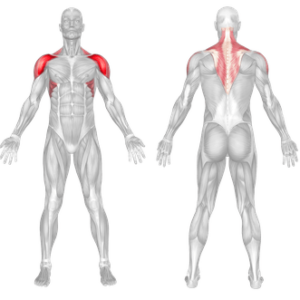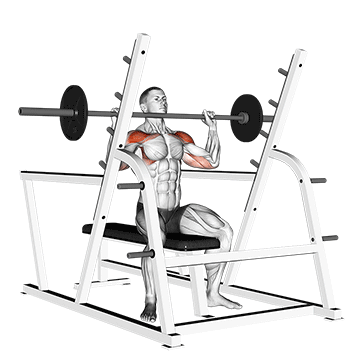Overview
The seated barbell shoulder press is a compound exercise that targets the muscles of the shoulders, triceps, and upper body. It involves pressing a barbell overhead while seated on a bench or chair. As a fundamental movement, it is frequently used in strength, power, and hypertrophy training.
How to Perform Seated Barbell Shoulder Press
Sit upright on a flat bench, keeping feet flat and planted slightly wider than hip-width.
Set the barbell at shoulder height on a rack and grip it slightly wider than shoulder-width.
Unrack the bar and bring it to shoulder level with elbows slightly in front of the bar.
Engage your core and glutes to maintain balance without a backrest.
Press the bar overhead, extending your arms without leaning backward.
Lower the bar under control back to your upper chest or shoulder line.
Tips for Proper Form
Sit tall and engage your core to prevent arching your lower back.
Grip the floor with your feet to create a stable seated base.
Keep your ribcage down to avoid excessive spinal extension.
Drive the bar in a straight path, slightly behind your head at the top.
Exhale as you press and inhale as you lower the bar.
Common Mistakes
Leaning too far back, turning the press into an incline chest press.
Using too much weight, which compromises form without the support.
Letting the elbows flare out, which strains the shoulder joints.
Losing core engagement, causing instability and poor posture.
Bouncing the bar off the chest, rather than controlling the descent.
Benefits of the Seated Barbell Shoulder Press
Builds Shoulder Strength: This press targets all three deltoid heads, with emphasis on the anterior and medial heads.
Improves Overhead Stability: Strengthens the muscles involved in overhead movements, boosting control and posture.
Minimizes Lower Body Compensation: The seated position reduces lower body involvement, focusing on upper-body pressing.
Promotes Muscle Growth: It’s a compound lift effective for hypertrophy in the shoulders and triceps.
Supports Athletic Performance: Improves pressing power useful in sports like football, swimming, and combat training.
Enhances Shoulder Balance: Helps develop symmetry and reduces strength imbalances in the upper body.
Improves Lockout Strength: Strengthens the final phase of any pressing movement, useful for bench pressing.
How to Incorporate Into Your Routine
- For Beginners: Start with 2–3 sets of 6–8 reps using a lighter barbell to master control and technique.
- For Hypertrophy: Perform 3–4 sets of 8–12 reps with moderate to heavy weight, focusing on time under tension.
- For Strength: Use 4–5 sets of 4–6 reps at a heavier load, resting 2–3 minutes between sets.
- For Functional Training: Pair with pulling movements (like rows) in supersets to train push-pull balance.
- For Circuit Training: Perform 8–10 reps as part of an upper-body strength circuit, minimizing rest.
- For General Fitness: Include 2–3 sets of 10 reps once per week to maintain shoulder strength.
- For Athletic Power: Combine with explosive movements like push presses or landmine presses for performance.
Muscles Worked

Frequently Asked Questions
Is this exercise harder than the seated press with back support?
Yes. Removing the backrest increases the need for core and postural muscle activation, making it more challenging overall.
What if I don’t have a bench with a backrest?
You can perform it seated upright without a backrest if your core is strong, or substitute with dumbbell shoulder presses.
Is the seated barbell shoulder press safer than the standing version?
Yes, the seated version reduces spinal loading and prevents using leg drive, making it safer for focused shoulder training.
Can I do this exercise with dumbbells instead?
Absolutely. Dumbbells allow a greater range of motion and are easier on the joints, but may be harder to stabilize.
How much should I lift on the seated press?
Start with a manageable weight to maintain form. Gradually increase load as strength improves.

